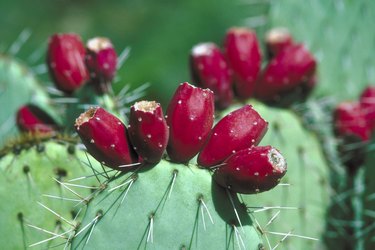
Cactus taxonomy classification is surprisingly contentious, with many names originally bestowed by gardeners and horticulturists rather than biologists – resulting in some individuals deciding to rename species and genera due to personal preferences, despite names already existing for these plants. A particularly enthusiastic German horticulturist named Curt Backeberg named or renamed 1,200 species without retaining a single representative of the species as an example. This is particularly frustrating, as the accepted practice among botanists is to preserve a representative specimen of a species to use as a reference for any uncertain identification. That said, the International Cactaceae Systematics Group established in 1984 has provided some basic agreed-upon classifications.
Cactus Kingdom and Phylum
Video of the Day
Cacti are situated within the Plantae Kingdom, growing by photosynthesis. They are also members of the Tracheophyta Phylum, which includes land plants with lignified tissues (hard and wood-like, containing lignin), for conducting water and minerals throughout the plant, as well as non-lignified tissue for conducting photosynthesis.
Video of the Day
Ferns and flowering plants also fall under this phylum.
Cactus Division and Classification
Within the Tracheophyta Phylum, cacti are classified as being within the Magnoliophyta Division, which are plants that bear flowers and produce seeds that contain endosperm (The substance within a plant seed which surrounds and provinces food for the embryo).
As a further specification, within the Magnoliophyta Division, cacti fall within the subdivision of Anthophyta, commonly known as Angiospermae. This subdivision includes flowering plants that produce seeds surrounded by a protective structure, called the "fruit," regardless of whether or not the fruit is edible.
This is the largest phylum in the Plantae Kingdom, containing at least 350,000 known species ranging from roses to mango plants.
Cactus Class and Order
Cacti are members of the paraphyletic (a category of taxonomy consisting of all the descendants of the last known common ancestor, excluding one or two examples) Dicotyledonae Class and the Caryophyllales Order.
Dicotyledonae are identified by seeds having two cotyledons (a kind of embryonic leaf inside of a growing seed), also known as "dicots." Within the Dicotyledonae Class, cacti are descended from the lineage of Magnoliopsida.
The Caryophyllales Order is characterized by adaptations to extreme environments. These adaptations are primarily focused on hostile conditions, such as limited access to moisture, highly alkaline or salinated soil and nutrient-poor soil. Besides the cactus, this order includes venus fly traps, mangroves and beets.
Cactus Family and Tribes
Finally, cacti are in the Family of Cactaceae. While some cacti can present woody (ligneous) stems, more commonly they are fleshy and succulent in nature when they aren't cladodes (broad, leaf-like stems that photosynthesize). The key factor distinguishing a cactus from other succulents is their needles, spines and prickles. These are actually the "leaves" of a cactus plant, and they emerge from areolae which hold the position of branches on other plants.
Cacti feature large, radially symmetrical flowers with several petals, sepals and stamens. Once fertilized, the ovary develops into a pulpy berry with many seeds. While there are well over 100 genera, cacti are categorized into three tribes, a category between family and genus in taxonomy. The Pereskieae Tribe has two genera, which is the primitive form of cacti, closer to forest trees. They are characterized by woody stems and leaves that are not necessarily succulent, with spines that cluster at the base of leaves and pendulous flowers.
Additional Tribe Information
A Prickly Pear cactus is an example of the Opunitieae Tribe, which can have larger spines or not, but the areolae always have glochids (small, fuzzy clusters of needles), which detach easily. They can have large pad-like or rounded fleshy stems that break off easily, but do not have ridges. The seed will be a seedy berry, sometimes covered in glochids.
Cactoidea makes up the largest tribe of genera within the Cactaceae Family, and has actually been further divided into eight sub-tribes, each with their own characteristics:
- Cereanae
- Hylocereanae
- Echinocereanae
- Echinocactaenae
- Cactanae
- Coryphanthanae
- Epiphyelanae
- Rhipsolidanae
The names of these sub-tribes, much like the species they consist of, are contended, as are the characteristics of each sub-tribe, though oddly the number of sub-tribes is not in contention.
- Enchanted Learning: Cactus Classification
- Mindat: Tracheophyta
- University of Virginia: Phylum Magnoliophyta
- Study: What are the Characteristics of the Phylum Anthophya?
- Garden Plants: Scientific Classification of Cactus
- Brain Kart: Bentham and Hooker's Classification of Plants
- Tree of Life: Caryophyllales
- Botanical Online: Catcus Family
- Wildflowers and Weeds: Cactaceae
- Biology Discussion: Top 3 Tribes of Cactus Plants
- Garden Beast: Guide to Opuntia